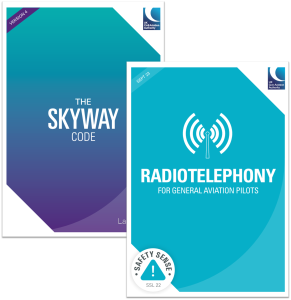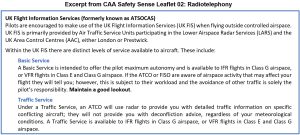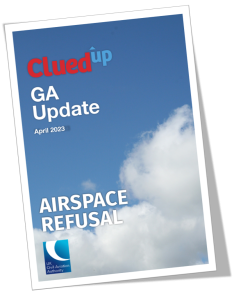ATC869 - Inadvertent airspace infringement
Initial Report
The incident resulted in an inadvertent infringement of [Airfield B Zone] as a result of pilot misunderstanding of [Airfield A and Airfield B] relationship. I was the pilot of a microlight on a lengthy planned UK flight. Due to limited clearance between cloud base and the terrain and reduced visibility the aircraft diverted from the planned course into lower ground rather than push on into rising terrain or divert [in opposite direction] where the terrain was even higher. I am not local to the area and had not flown there previously. The diversion route had to be quickly worked out and followed and reliance was made on the SkyDemon moving map and using the local knowledge of the controllers to assist.
I asked for and received a basic service from [Airfield A] LARS since I would be crossing their area and was wearing a transponder code allocated by the controller. I was additionally monitoring [Airfield B frequency] as I routed towards [Airfield B Zone]. My aircraft entered [Airfield B Zone] with a service from [Airfield A] and stayed with [Airfield A] who passed information whilst I was transiting [Airfield B Zone]. I left [Airfield B Zone] and requested a change to [Airfield C]. [Airfield A] controller did not pass the aircraft over to [Airfield B] at any stage nor suggest a frequency change and continued to provide a basic service. No relevant transmissions from [Airfield B] were heard on the monitored frequency. I remained outside [Airfield B] ATZ throughout.
I assumed that the [Airfield A] controller did not hand me over to [Airfield B] because it wasn’t needed due an operational agreement between [the two]. I remembered mention of operations [between the two airfields with a specific agreement] in an earlier preflight brief. SkyDemon flashed a brief warning regarding [Airfield B Zone] just as the aircraft entered it.
I remember there was a second aircraft with a similar call sign on [Airfield A] frequency and then [Airfield C] frequency at the time. The pilot of G-XXXX requested clarification from [Airfield A] due to confusing call signs and messages relating to service. Shortly after [Airfield C] controller explicitly requested full call signs and this request was acknowledged by the pilot of G-XXXX. It may be that that the confusion due to similar call signs led to the [Airfield A] controller not handing me off.
I had no reason to suspect anything was wrong until the CAA infringement team sent out a letter requesting information relating to an alleged infringement inside [Airfield B Zone] by [my aircraft] wearing a code that was not from [Airfield B].
After receiving the CAA letter, I contacted ATC [at Airfields A and B] and explained what had happened and apologised to [Airfield B]. It transpires that the operational agreement I recollected whilst airborne did not include non-[Airfield A-based] aircraft. [Airfield B] are happy to offer a ‘LARS like’ service for the [Airfield A operating area] because their radar coverage overlaps. [Airfield B] radar service and coverage is not shown on CAA or NATS literature, but they are essentially a LARS. [Airfield B] was not busy and the controller explained that they knew the aircraft was likely on [Airfield A] frequency but didn’t blind call me on [frequency] or phone [Airfield A], before the aircraft had changed to [Airfield C]. [Airfield B] did not have the ability to see Mode S and call signs natively and later identified the aircraft using an online ADSB service to file a MOR.
Lessons Learned: I made the mistake of assuming that the [Airfield A] controller would hand me off to [Airfield B] if it was necessary and if they didn’t then it wasn’t necessary due to [a local operational agreement]. Unfortunately, basic service can be really basic.
CHIRP Comment
A microlight pilot inadvertently infringed controlled airspace, discovering the breach only afterwards. They subsequently reported the event to CHIRP and thoughtfully analysed the contributing factors for wider learning. CHIRP is grateful to the reporter for their openness and for sharing the safety lessons that arise. The incident was also reviewed by the CAA’s Infringement Coordination Group (ICG); CHIRP’s reflections here focus only on the human factors evident from the report.
There appear to have been several mitigating and compounding elements that contributed to the pilot’s misunderstanding and procedural error during a weather-related diversion. The reporter’s observation that “a basic service is very basic” is a fair reminder that many GA pilots still misunderstand the limitations of Air Traffic Services (ATS) outside controlled airspace. We’ve provided a brief refresher of the main UK Flight Information Services at the end of this article; more detail can be found in CAP774: UK Flight Information Services and CAA Safety Sense Leaflet 22: Radiotelephony.

When operating outside controlled airspace, particularly during diversions or under high workload, pilots are encouraged to request a Traffic Service (TS) where available. As well as supporting your geographic spatial awareness, a TS also helps mitigate the risk of mid-air collision. If a TS is declined, it is entirely acceptable to explain the circumstances and ask ATC for assistance. Although the controllers’ actions were technically correct in this case, there might have been scope for a more proactive handover or supportive coordination, given the pilot’s weather diversion and unfamiliarity with the area. Aviation is, after all, a team activity.
A key lesson that emerges is: “never assume, always check.” GA pilots sometimes hesitate to make non-standard R/T calls, but if unsure, it is always better to ask rather than assume. Perfect phraseology is far less important than maintaining situational awareness. On longer flights, especially in unfamiliar airspace, effective pre-flight planning and robust Threat & Error Management (TEM) reduce the likelihood of an infringement and preserve capacity when things change in flight. More comprehensive TEM might also have prevented the confirmation bias that led the pilot to discount the SkyDemon alert. Instructors may wish to use this example when training for in-flight replanning and diversion exercises, incorporating FREDA checks and R/T practice into the process.
In this case, the infringement came to light only when the CAA’s ICG contacted the pilot following the submission of a Mandatory Occurrence Report (MOR) by ATC. The pilot’s subsequent engagement with ATC and CHIRP were commendably open. MORs are not punitive; they exist to promote systemic learning. The CAA’s CAP1404: Airspace Infringements process ensures that each case is reviewed fairly and proportionately by the ICG. Notably, no pilot in the UK has ever lost their licence solely as a result of an infringement, yet lingering myths continue to discourage some from engaging with the process. Over half of all cases are closed with advisory letters; only repeat or serious occurrences typically require additional training, such as the Infringement Awareness Course, which in itself is an excellent learning opportunity. Pilots who suspect they may have infringed are encouraged to contact the ICG proactively and explain the circumstances. Of note, the ICG review of this inadvertent infringement included an educational letter to the pilot pertaining to possible safety improvements in things like pre-flight planning.
Finally, CHIRP has reflected on the broader issue of trust between GA pilots and regulatory bodies such as the CAA, UKAB and AAIB. Some pilots still perceive these organisations as punitive rather than supportive. Just as we encourage pilots to engage openly with the system, safety bodies must reciprocate by communicating clearly, constructively and respectfully. CHIRP understands that the tone of some earlier CAA correspondence was perceived as unfriendly but welcomes the recent shift towards a more inclusive and helpful style, which appears to have improved pilot engagement with CAP1404 overall. We encourage readers to continue sharing their experiences – positive or negative – so that this feedback can further strengthen safety culture and understanding.

As an aside, have you ever decided not to request a Traffic Service because you thought there was no point and it would just be refused? The problem with this kind of ‘learned helplessness’ is that it leaves no record of the issue. Much better to ask. You’ll either receive the service – result – or be denied, often due to controller workload. In that case, you can helpfully share the experience with the CAA using the UK Airspace Access or Refusal of ATS Report Form (FCS1522). Submitting this form helps the CAA collect data on refusals and supports work towards improved airspace access and safer services for all.

Key Issues relating to this report
Human Factors Considerations
The following ‘Dirty Dozen’ and Human Factors were a key part of the CHIRP discussions about this report.
Positive factors:
- Safety mindset – open reporting and willingness to share lessons for collective learning.
- Situational awareness recovery – effective use of post-event reflection to identify gaps in planning and communication.
- Communication/Learning – recognition of personal error and engagement with ATC to better understand events and prevent reoccurrence.
- Adaptability – safe decision to divert rather than continue into deteriorating weather or rising terrain.
Negative influences:
- Skill/Decision Error – assumption that an ATC handover would occur automatically under a Basic Service.
- Situational awareness – incomplete understanding of local airspace relationships and service responsibilities.
- Confirmation bias – disregarding the SkyDemon alert owing to an expectation of controller coordination.
- Coordination/Communication – lack of clarification between ATC units and pilot about service expectations.
- Time pressure and workload – cognitive overload from weather, terrain, unfamiliar airspace and R/T distractions contributing to reduced monitoring.
- Complacency / procedural drift – reliance on assumed operational agreements rather than confirmation.